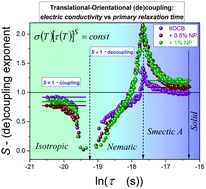The fluctuation-driven dielectric properties of liquid crystalline 8OCB and its nanocolloids
Abstract
Results of broadband dielectric spectroscopy studies in liquid crystalline octyloxycyanobiphenyl (8OCB) and its colloids with BaTiO3 nanoparticles (paraelectric, diameter d = 50 nm) are presented. Studies were carried out in isotropic liquid, nematic, smectic A and solid crystalline phases. They are supported by derivative-based and distortion-sensitive analyses, revealing a set of universal scaling patterns for temperature evolution of static and dynamic dielectric properties. All these yielded evidence for a pretransitional fluctuation impact on the dielectric constant, primary relaxation time, loss curve maximum and translational–orientational decoupling associated with anomalous values of the fractional Debye–Stokes–Einstein (DSE) exponent 0.2 < S < 2.2. The evidence for critical like changes in a distribution of relaxation times is shown. For mesophases, a tiny addition of nanoparticles causes permanent orientation of LC molecules, leading even to a 16% increase of the dielectric constant above a maximal value in pure 8OCB. A split of two regions, dominated by pre-isotropic and pre-smectic fluctuations, is evidenced. Model explanations for detected phenomena, particularly in the isotropic liquid phase, are presented. New evidence for a premelting effect in the solid phase is also shown.



 Please wait while we load your content...
Please wait while we load your content...